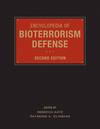
Encyclopedia of Bioterrorism Defense, 2nd Edition
| List Price: | US $530.25 |
| Government Price: | US $366.68 |
Encyclopedia of Bioterrorism Defense, 2nd Edition
Apart from the dark shadow of a mushroom cloud rising above a decimated city there are few threats which have captured the public imagination more than the prospect of bioterrorism. Yet, ten years since the declaration of the ‘war on terror’ how much of a threat do bioterrorist attacks represent and how prepared are we to defend ourselves?
In the Encyclopedia of Bioterrorism Defense, 2nd Edition Dr Rebecca Katz and Dr Raymond Zilinskas present a unique and comprehensive guide to bioterrorism, a groundbreaking survey of science, medicine, technology, politics and law.
This authoritative title benefits from the extensive expertise and prestigious careers of its authors. As a consultant to the US State Department Dr Katz is an international expert on public health preparedness and the intersection of infectious disease and national security. Dr Ziliskas examined the proliferation potential of the Soviet Union’s biological warfare program before serving the United Nations as a biological weapons inspector in Iraq.
“Bioterrorism can be defined as the use, or threatened use, of biological agents against people, plants or animals to promote or spread fear, intimidation, or cause morbidity or mortality in civilian populations,” said Katz. “Interestingly many of the traditional biological weapons agents are found in nature, and many are disseminated using methods such as aerosolization and food or water contamination.”
After exploring diseases such as anthrax, plague and small pox the Encyclopedia of Bioterrorism Defense, 2nd Edition offers analysis of detection mechanisms, the clinical presentation of disease, risk assessments and past incidents of bioterrorism.
The Encyclopedia also considers countries defined by the United States government as nations of concern such as Syria and Iran as well as terrorist groups including Al-Qaeda and Hezbollah to identify the source of bioterror threats. Entries also cover international treaties as well as the pertinent people and organizations either engaged in, or combating, global terrorism.
“The increased recognition of the threat of bioterrorism, combined with the attacks of 2001, has led to a dramatic increase in efforts to create a robust biodefense infrastructure,” said Katz. “This has included federal, state and government entities to detect threats, prepare for possible attack and respond effectively to bioterrorism.”



